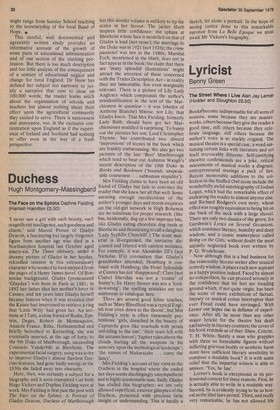Duchess
Hugh Montgomery-Massingberd
The Face on the Sphinx Daphne Fielding (Hamish Hamilton £5.50) 'I never saw a girl with such beauty, such magnificent intelligence, such goodness and charm,' said Marcel Proust of Gladys Deacon, a fascinating but largely forgotten figure from another age who died in a Northampton hospital last October aged ninety-six. The Times obituary, under a dreamy picture of Gladys in her heyday, rekindled interest in this extraordinary character who seemed to have stepped from the pages of a Henry James novel. Of Bostonian background, Gladys (pronounced `Glaydus) was born in Paris in 1881; in 1892 her father shot her mother's lover in Cannes, and ten years later Gladys herself became famous when it was revealed that the Kaiser had intervened to retrieve a ring that 'Little Willy' had given her. An intimate at I Tatti, a close friend of Rodin, Epstein, Degas, Robert de Montesquiou, Anatole France, Rilke, Hofmannsthal and briefly betrothed to Keyserling, she was eventually married, at the age of forty, to the 9th Duke of Marlborough, succeeding Consuelo Vanderbilt at Blenheim. The experimental facial surgery, using wax to try to improve Gladys's almost flawless Grecian features, had gone badly wrong; in the 1930s she faded away into obscurity.
Here, then, was certainly a subject for a biography and it soon transpired that both Hugo Vickers and Daphne Fielding were at work. Mrs Fielding is first past the post with The Face on the Sphinx: A Portrait of Gladys Deacon, Duchess of Marlborough but this slender volume is unlikely to tip the scales in her favour. The jacket blurb inspires little confidence: the sphinx at Blenheim whose face is modelled on that of Gladys is lead (not stone); the marriage to the Duke was in 1921 (not 1926); the crime passionel was not in the 1880s; Marshal Foch, mentioned in the blurb, does not in fact appear in the book; the claim that there are 'many splendid illustrations' might attract the attention of those concerned with the Trades Description Act in reality they are lamentable, few even marginally relevant. There is a picture of Lily Lady Anglesey which compounds the author's misidentification in the text of the Marchioness in question — it was (shades of Anthony Blanche) Minnie, not Lily, that Gladys knew. That Mrs Fielding, formerly Lady Bath, should have got her Marchionesses muddled is surprising. To bump out the pictures her son, Lord Christopher Thynne, has contributed two absurd 'impressions' of scenes in the book which are frankly embarrassing. We also get two pictures of the late 'Bert' Marlborough which tend to bear out Auberon Waugh's recent description of the 10th Duke in Books and Bookmen ('boorish, unspeakable coarseness . . . subhuman stupidity).
Mrs Fielding claims to have been an old friend of Gladys but fails to convince the reader that she knew her all that well. Some amusing enough recollections of the author's younger days and recent enquiries on the old-girl network in High Bohemia are no substitute for proper research. (She has, incidentally, dug up a few improper bits, like Gladys eating chocolate dog turds at Blenheim and threatening to call a daughter 'Lady Syphilis Churchill'.) The scant material is ill-organised, the narrative disjointed and littered with careless mistakes. For example, it was Alexander III's (not Nicholas II's) coronation that Gladys's grandfather attended; Homburg is confused with Hamburg; the Hotel Splendide at Cannes has not `disappeared'; Clare (not Claire) Sheridan was not a 'cousin' of Sunny's; Sir Harry Stonor was not a 'lordin-waiting'; the spelling mistakes are too numerous to catalogue here.
There are several good feline touches, such as 'Mary Blandford was a typical English rose even down to the thorns', but Mrs Fielding's style is often tiresomely pretentious: 'girls, drenched in the beauty of Caprarola grew like rosebuds with petals unfolding to the sun'; 'their tears fell with the autumn leaves'; `Jupiter rides above the clouds hurling all the weapons in his armoury upon the mythological landscape'; 'the names of Maharajahs . . . curry the fancy'.
Mrs Fielding's account of her visits to the Duchess in the hospital where she ended her days seems disobligingly unsympathetic and in highly questionable taste. Sadly, Gladys has eluded this biographer; we are only allowed superficial, exterior glimpses of the Duchess, presented with precious little insight or understanding. This is hardly a sketch, let alone a portrait. In the hope of seeing justice done to this remarkable survivor from La Belle Epoque we must await Mr Vickers's biography.


































 Previous page
Previous page